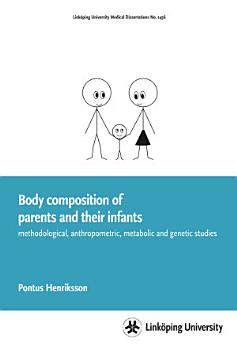Body composition of parents and their infants: methodological, anthropometric, metabolic and genetic studies
About this ebook
Parent couples were invited to this study at a routine visit to a maternity clinic in Linköping between September 2008 and October 2010. When the mother was in gestational week 32, parental body composition using ADP and maternal glucose homeostasis variables were assessed. Size and body composition of healthy, singleton and full term (≥ 37 gestational weeks) infants were measured at 1 and 12 weeks of age and a total of 211 infants were included in the studies. Weight and length at 1 year of age were reported by parents. Saliva samples were collected from the infants to obtain DNA for genotyping of the fat mass and obesity associated (FTO) gene.
Body composition results calculated using measured and predicted TGV were compared in 27 women. Results showed that predicted TGV yields a very marginal overestimation (0.5 %) of fat mass (FM). Further, each kg increase in maternal and paternal fat-free mass (FFM) was associated with 15.6 g (P=0.001) and 9.1 g (P=0.007), respectively, more FFM in their 1-week old infants. FM of fathers was not related to infant FM. However, maternal FM was positively associated with FM of daughters (5.8 g/kg, P=0.007), but not of sons (P=0.79) at 1 week of age. Similarly, each standard deviation increase in maternal HOMA-IR (homeostatic model assessment-insulin resistance) was related to 52.7 more g of FM (P<0.001) in 1-weekold daughters, but no such relationship was found for sons (P=0.79). The number of risk alleles at the FTO locus rs9939609 was not associated with infant body mass index (BMI) or infant FM at 1 or 12 weeks of age. However, the number of risk alleles was positively associated (P≤0.033) with infant length at 1 and 12 weeks of age, and the results suggested that this association was stronger in boys than in girls.
The results presented in this thesis show that: i) The use of predicted TGV when applying ADP in gestational week 32 overestimated % FM only slightly. ii) Associations between parental and infant body composition are present early in life. Thus, parental FFM was positively related to FFM in 1-week-old infants. Furthermore, maternal FM and insulin resistance (HOMA-IR) were positively related to FM of 1-week-old daughters, but no such relationships were observed for sons. iii) The FTO genotype is not associated with infant body fatness at 1 or 12 weeks of age. However, the results suggested that the number of FTO risk alleles is positively associated with infant length, especially in boys.
In conclusion, parental and genetic factors were associated with infant size and body composition and these relationships may be of importance for future body composition and health.
Ratings and reviews
- Flag inappropriate




